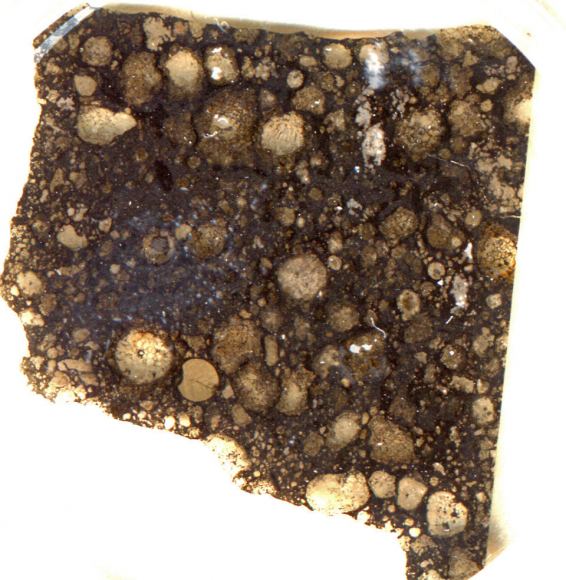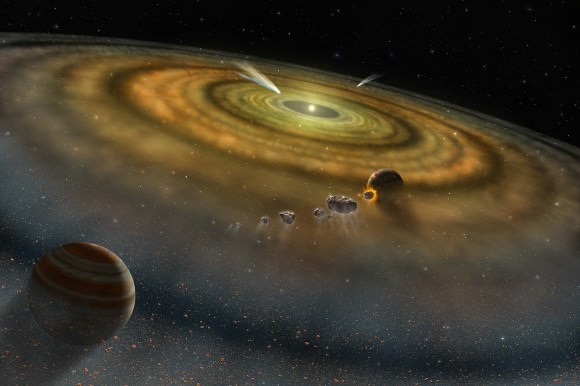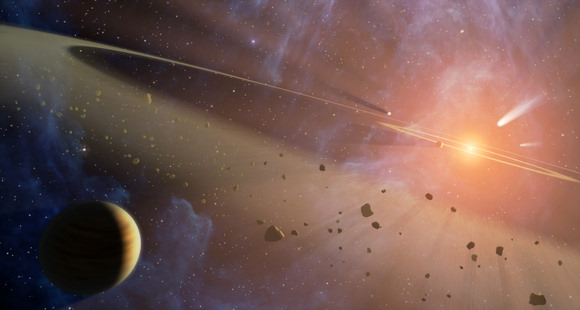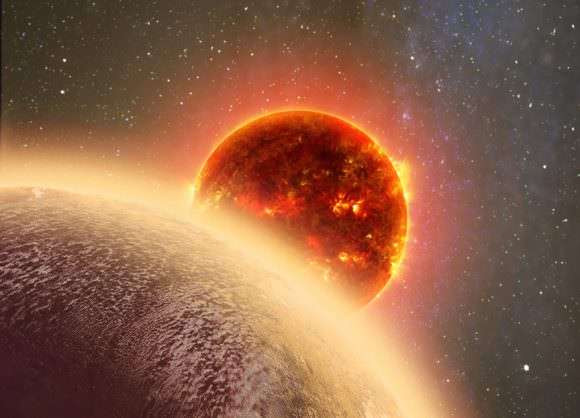According to the Nebular Hypothesis, the Sun and planets formed 4.6 billion years ago from a giant cloud of dust and gas. This began with the Sun forming in the center, and the remaining material forming a protoplanetary disc, from which the planets formed. Whereas the planets in the outer Solar System were largely made up of gases (i.e. the Gas Giants), those closer to the Sun formed from silicate minerals and metals (i.e. the terrestrial planets).
Despite having a pretty good idea of how this all came about, the question of exactly how the planets of the Solar System formed and evolved over the course of billions of year is still subject to debate. In a new study, two researchers from the University of Heidelberg considered the role played by carbon in both the formation of Earth and the emergence and evolution of life.
Their study, "Spatial Distribution of Carbon Dust in the Early Solar Nebula and the Carbon Content of Planetesimals", recently appeared in the journal Astronomy and Astrophysics. The study was conducted by Hans-Peter Gail, from the Institute for Theoretical Astrophysics at the University of Heidelberg, and Mario Trieloff - from Heidelberg's Institute of Earth Sciences and the Klaus-Tschira-Laboratory for Cosmochemistry.

A slice of the Allende meteorite with silicate globules of the size of a millimetre. Credit: Institute of Earth Science
For the sake of their study, the pair considered what role the element carbon - which is essential to life here on Earth - played in planetary formation. Essentially, scientists are of the opinion that during the earliest days of the Solar System - when it was still a giant cloud of dust and gas - carbon-rich materials were distributed to the inner Solar System from the outer Solar System.
Out beyond the "Frost Line" - where volatiles like water, ammonia and methane and are able to condense into ice - bodies containing frozen carbon compounds formed. Much like how water was distributed throughout the Solar System, that these bodies were supposedly kicked out of their orbits and sent towards the Sun, distributing volatile materials to the planetesimals that would eventually grow to become the terrestrial planets.
However, when one compares the kinds of meteors that distributed primordial material to Earth - aka. chondrite meteorites - one notices a certain discrepancy. Basically, carbon is comparatively rare on Earth compared to these ancient rocks, the reason for which has remained a mystery. As Prof. Trieloff, who was the co-author on the study, explained in a University of Heidelberg press release:
"On Earth, carbon is a relatively rare element. It is enriched close to the Earth´s surface, but as a fraction of the total matter on Earth it is a mere one-half of 1/1000th. In primitive comets, however, the proportion of carbon can be ten percent or more."

Artist's conception of a solar system in formation. Credit: NASA/FUSE/Lynette Cook
"A substantial portion of the carbon in asteroids and comets is in long-chain and branched molecules that evaporate only at very high temperatures," added Dr. Grail, the study's lead author. "Based on the standard models that simulate carbon reactions in the solar nebula where the sun and planets originated, the Earth and the other terrestrial planets should have up to 100 times more carbon."
To address this, the two researches constructed a model that assumed that short-duration flash-heating events - where the Sun heated the protoplanetary disc - were responsible for this discrepancy. They also assumed that all matter in the inner Solar System was heated to temperatures of between 1,300 and 1,800 °C (2372 to 3272 °F) before small planetesimals and terrestrial planets eventually formed.
Dr. Grail and Trieloff believe the evidence for this lies in the round grains in meteorites that form from molten droplets - known as chondrules. Unlike chondrite meteorites, which can be composed of up to a few percent carbon, chondrules are largely depleted of this element. This, they claim, was the a result of the same flash-heating events that took place before the chondrules could accrete to form meteorites. As Dr. Gail indicated:
"Only the spikes in temperature derived from the chondrule formation models can explain today's low amount of carbon on the inner planets. Previous models did not take this process into account, but we apparently have it to thank for the correct amount of carbon that allowed the evolution of the Earth's biosphere as we know it."

Artist impression of the Late Heavy Bombardment period. Credit: NASA
In short, the discrepancy between the amount of carbon found in chondritic-rock material and that found on Earth can be explained by intense heating in the primordial Solar System. As Earth formed from chrondritic material, the extreme heat caused it to be depleted of its natural carbon. In addition to shedding light on what has been an ongoing mystery in astronomy, this study also offers new insight into how life in the Solar System began.
Basically, the researchers speculate that the flash-heating events in the inner Solar System may have been necessary for life here on Earth. Had there been too much carbon in the primordial material that coalesced into our planet, the result could have been a "carbon overdose". This is because when carbon becomes oxidized, it forms carbon dioxide, a major greenhouse gas that can lead to a runaway heating effect.
This is what planetary scientists believe happened to Venus, where the presence of abundant CO2 - combined with its increased exposure to Solar radiation - led to the hellish environment that is there today. But on Earth, CO2 was removed from the atmosphere by the silicate-carbonate cycle, which allowed for Earth to achieve a balanced and life-sustaining environment.
"Whether 100 times more carbon would permit effective removal of the greenhouse gas is questionable at the very least," said Dr. Trieloff. "The carbon could no longer be stored in carbonates, where most of the Earth's CO2 is stored today. This much CO2 in the atmosphere would cause such a severe and irreversible greenhouse effect that the oceans would evaporate and disappear."

Artist's impression of the "Venus-like" exoplanet in a nearby star system. Credit: cfa.harvard.edu
It is a well-known fact that life here on Earth is carbon-based. However, knowing that conditions during the early Solar System prevented an overdose of carbon that could have turned Earth into a second Venus is certainly interesting. While carbon may be essential to life as we know it, too much can mean the death of it. This study could also come in handy when it comes to the search for life in extra-solar systems.
When examining distant stars, astronomers could ask, "were primordial conditions hot enough in the inner system to prevent a carbon overdose?" The answer to that question could be the difference between finding an Earth 2.0, or another Venus-like world!
Further Reading: University of Heidelberg, Astronomy and Astrophysics


